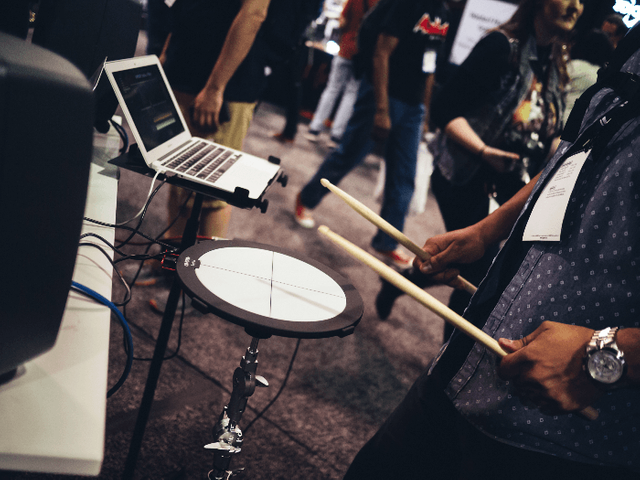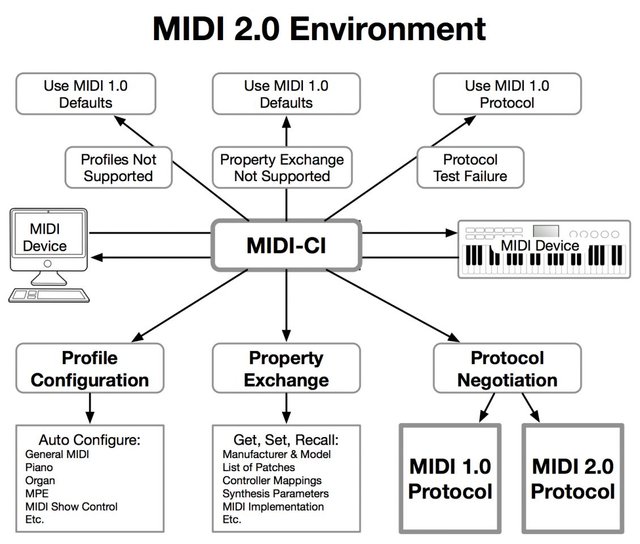- The MIDI Manufacturers Association (MMA) has just announced MIDI 2.0 at NAMM 2019.
- Learn why MIDI 2.0 is set to change the face of music production as we know it.
- The latest on MIDI 2.0's development, including potential specs and future applications.

An overview of MIDI
MIDI (or Musical Instrument Digital Interface) is a protocol designed to allow for the communication of musical devices via the 1’s and 0’s of the digital landscape. In other words, MIDI is a set of code rules (or a language) that allows our musical instruments, hardware and software to effectively communicate with each other.Manufacturers of musical hardware and software have generally agreed that MIDI is how musical communication takes place electronically.
The technical specifications (commonly called “tech specs”) written for MIDI in 1982 are essentially a guide that lays out for manufacturers how to develop
products that “speak” the MIDI language to one another.
As such, an overhaul of the tech specs is a big deal. The MIDI Association is overhauling a language for the first time in 37 years.
MIDI's early beginnings
So how did we get to this point? It’s time to take a look back to the 1983 Winter NAMM show.
Two synthesizers, the Sequential Circuits Prophet-600 and the Roland Jupiter-6, are sitting back to back on a table, linked by a cable. People gather to watch as a key is pressed, and both synths simultaneously play the note. That was the world’s introduction to MIDI 1.0, and obviously, it went well, since it’s still worth writing about today.
However, MIDI 1.0 has undergone revisions and improvements since the original specifications were published, mostly to keep up with technical improvements and for streamlining. The fundamentals of the protocol have remained unchanged, however, which brings us to where we are now.

A basic illustration of a simple MIDI network. Credit to Indiana for the photo.
MIDI by today's standards
MIDI is no longer just a language used by musical technology. It’s the language used by musical technology.
In fact, it’s so useful for conveying information, particularly information with a rhythmic component, that it’s even been used for lighting and visuals, allowing DJs to improvise in their sets without their visuals missing a single cue.
In addition, it’s become a foundational piece of electronic music creation, in some circles, more vital than a microphone in terms of utility. Obviously, it’s more than capable, but just like anything, it can be further improved.
As of March 12, 2018, the MIDI Manufacturers Association (MMA) released a technical specification for an expanded feature of MIDI titled MPE (MIDI Polyphonic Expression).
It’s an exciting new bit of protocol that allows MIDI to apply expression, such as pitchbend or timbral controls, to individual notes of a chord independently of one another. ROLI, a company that is “changing the way people make music”, has implemented this technology in multiple products, including their pseudo-keyboard, the ROLI Seaboard.
To remain innovative, one would expect many companies to be jumping on board, but at the moment, only a few companies have released products taking advantage of this new feature. This highlights a crucial concern for MIDI 2.0.
Ideally, the tech specs will be thrust unto the world and manufacturers will be rolling out new, MIDI 2.0-capable devices right on its heels. After all, mavericks like Ableton and Native Instruments have joined the MMA, according to a press release by The MIDI Association from November 2018, but perhaps this will simply be a larger scale repeat of MPE.
Perhaps these features will remain accessible, but unused, except by a group of innovators making silicone keyboards in East London.
How soon can we expect to see MIDI 2.0?
At the moment, MIDI 2.0 is in its prototype phase. The technical specifications have been rewritten, but only a select group can see them, and they’re making the first attempts at implementation. As the updated protocol is put in place, it will undergo revisions to perfect it and to remedy unforeseen issues.
Once MIDI 2.0 is capable, stable, and finalized behind closed doors, the specification will be available for all to use. And that’s when we’ll begin to see MIDI 2.0-enabled devices flooding the market, hopefully.
So what does MIDI 2.0 mean going forward?
The most exciting part, however, is what it’s actually going to be like, and honestly, no one knows for certain yet. There are a whole lot of potential features which will probably be there, but the exact combination of new features isn’t set in stone until it’s actually released.
More than likely, we can expect to see the following:
- Backwards-compatible applications
- Web-based integration
- 256 MIDI Channels
- 32-bit resolution

Backwards compatibility is critical
The MIDI Association has made it clear that backwards compatibility is their highest priority with MIDI 2.0.
With millions of MIDI 1.0 devices around the world, it would be a terrible shortcoming for the old and the new to be unable to communicate, and so we have the MIDI Capability Inquiry, or MIDI-CI for short. MIDI-CI is already a complete and finished specification that will be engaged immediately upon the MIDI connection of two devices. It stipulates that one device sends off a message to the other, and the response determines which protocol is used, MIDI 1.0 or MIDI 2.0.
[su_box title="An Important Caveat..."]As long as MIDI-CI is met with the appropriate response for capability, MIDI 2.0 is used for the exchange of musical information. Otherwise, both devices fall back to MIDI 1.0. This prevents devices that aren’t prepared for MIDI 2.0 to be cut off from usability. They’ll function exactly as they always did, but limit the capabilities of the MIDI 2.0 device on the other side to a mere MIDI 1.0 device.[/su_box]
The other potential features are less defined right now, as their tech specs have yet to be available publicly, but some information is known.
For example, instead of having 16 MIDI channels, MIDI 2.0 proposes 256.
This would allow the potential of such things as playing an entire orchestra concurrently from one keyboard all as individual software instruments, presuming the host computer was up to such a feat.
It also suggests web-based integration.
This could open up an entirely new world of possibilities for software instrument distribution, preset sharing, and user-driven sound integration in web design. However, it opens up doorways to security vulnerabilities for music makers, which will need to be thoroughly protected against.
32-bit resolution has also been mentioned as an upgrade upon MIDI 1.0’s 7 bits.
1 bit resolution would give 21, or 2, potential values: 0 or 1. 2 bit resolution would be 22, or 4, potential values: 00, 01, 10, or 11. Continue to 7-bit resolution, and you have 27, or 128, potential values, which when translated from binary to decimal are the values 0-127. This is the range of values that can represent velocity and pitchbend, among others.
With the proposed 32 bits of resolution, MIDI 2.0 is offering 232 potential values. That works out to 4,294,967,296 values, or about 33.5 million per 1 value available with MIDI 1.0.
This may be overkill, but then again, it may never need to be upgraded after this, as the difference between a pitchbend value of 0 and a pitchbend value of 0.000000029 (1/33.5 million of a MIDI 1.0 value) would in most cases be imperceptible.
Final thoughts
As MIDI 2.0 looms on the horizon, there’s plenty to speculate, suggest, and be excited about, but for now, we’ll just have to wait and see what the MMA has in store for us. Most importantly, it’s crucial that music makers are looking ahead in the interim, and brainstorming about these new possibilities now. Let us know in the comments what you are most excited for regarding MIDI 2.0.